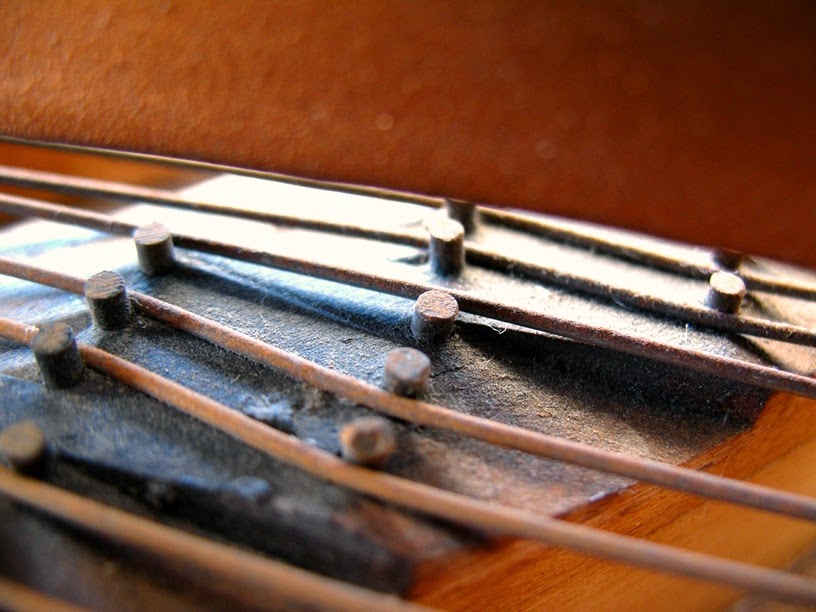The Caped Regulators travel far and wide, traversing Greater Sydney and beyond, rescuing pianos in distress and giving them medicinal brandy.
Here we encounter an interesting and troubled American piano. Unorthodox repair strategies can be generously deemed to be halfway legitimate in times of prairie austerity, but we are not responsible for these treble hammer toupees. A veritable Donald Trump L'oeil.
The poor little threadbare peckers, with their astroturf additions, didn't sound completely offensive, under the circumstances.
Client reports of 'some keys are broken' rarely prove to be this literal. It is more common for the problems to be further along the complex chain of events in the action.
Careful glueing and clamping ensues.
A common unpleasant sight (rusty coils) but with a difference. At least two thirds of the string coils' entry points into the tuning pins (the beckets) were oddly and precariously protruding. How did they get like that? It is most likely that this important aspect of installing strings was skimped-on or neglected.
It makes the notion of pitch raising this piano seem more hair-raising. Solution/improvement: mass squeezing in of the many protruding beckets with the appropriate pliers.
What's amiss here? Discounting rampant rust, a string is not correctly located around the bridge pins. Solution: reduce the tension on the string and coax it into the correct position with a stringing hook.
The New Equalizing Scale is not so new. It sounds like a pollie policy from the Depression Era, which seems a generationally-accurate fit for this piano. Rust just disappears in monochrome... but the dirty, cracked soundboard remains.
Those patent dates seem just like yesterday. I think the piano dates from the 1920s or '30s.
Keys out ready to clean the keybed. Wow, this old piano really is an American... look at those whiter-than-white teeth!
Out on the spacious deck, vacuum and brush to hand. Compressed air is also useful for these jobs. The trick is to know how or what to suck, or blow - it would be quite easy for the uninitiated to accidentally Hoover up legitimate piano parts. Conversely, if, with compressed air, cloth, cardboard and paper punchings (washers) behave like dandelion spores, it is time to replace them. Today's cleaning involves attempting not to disturb too many pieces of ageing regulation adjustment material.
Cleaning the uncleanable. We're not to know the provenance of this blemish. I have encountered another respectable piano where the owner intimated that the cats liked to... yes... eew...
...but I don't implicate THIS aged, mangy little moggy. Photographed through the glass, not allowed indoors - incontinent, I'm told.
Attack of the Alien Overlords? Or roller skates for grand pianos.
The perfectly-proportioned lever enables a scrawny weakling (me) to lift the corner of a grand piano single-handedly. A huge collection of socket options ensures that the piano legs' fixings can't stymie us.
Now this piano is ready to Xanadu* around the capacious kitchen and living area, gliding in and out of varied dinner party scenarios.
In the Art Gallery of New South Wales there is an installation comprising repurposed piano bits, and player piano bits in particular. I fantasize of negating the shock of condemning a clunker by suggesting, 'Your piano has the potential to grace the finest galleries, madam, as a profound work of art... but certainly not as a musical instrument.'
An equally intriguing installation, but this is no gallery. This (functioning) player piano mechanism is carefully removed so that we may attend to several string replacements and other repairs to the normal bits behind all this palaver. I normally say, 'I deal with the PIAN, not the OLA.' to explain that I do not repair or maintain player piano mechanisms. I either reach around the OLA to access the PIAN, if the piano is even worth attempting to tune. I've never removed and re-installed a player mechanism, and would never have attempted it alone. Fortunately, my intrepid partner in piano-pampering has been through this enough times before to know the tricks. A blend of plumbing and bicycle maintenance, it's further testament to the wacky diversity in piano work.
All the little bellows below.
The piano resides in the High Dependency Unit of an Aged Care Facility. There is a fine selection of piano rolls, many of the type which would not be able to be published today, one imagines.
Finally the Aeolian has had its sonic facelift, including a pitch raise from a semitone below, then a tuning, the replacement of a missing hammer head on Middle C, no less, and several new plain wire strings. It's a good outcome that matched the client's needs, budget, and what was appropriate and realistic at this stage, for this piano.
'We specialize in the care of aged pianos.' Hmmm, not necessarily. We must triage pianos on a case-by-case basis and determine whether or not we can assist you with you High Dependency piano.
Check out the Caped Regulators in their first two-minute feature film...
* Eighties roller skating reference, rarely, if ever, used as a verb.
Similar Posts:




















